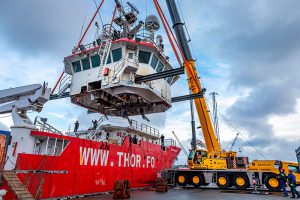PSVs Converted to Multi-Purpose Vessels
 Ship design and engineering company GLO Marine, based in Galati, Romania, has completed two projects enabling the conversion of two redundant platform supply vessels (PSVs) to multi-purpose vessels optimised to support offshore renewables operators.
Ship design and engineering company GLO Marine, based in Galati, Romania, has completed two projects enabling the conversion of two redundant platform supply vessels (PSVs) to multi-purpose vessels optimised to support offshore renewables operators.
Using the experience gained from these projects, GLO Marine has codified the development of standardised, highly efficient work flows into a series of step-by-step methodologies that enable them to deliver the SPS class notations that underpin these conversions quickly, cost-effectively and accurately. The two vessels on which GLO Marine developed these methodologies were offshore oil & gas PSVs, 91 and 55 metres in length respectively. The former has been repurposed from offshore subsea activities to general renewables support including the capability to host temporary living quarters for up to 40 personnel. The primary element of the conversion of the second vessel was the addition of an extra deck to accommodate 32 people personnel.
The key element of conversions of this type is the requirement to achieve SPS Class notation. This is a challenging task when involving offshore vessels as the code is considerably more stringent than offshore codes, in terms of stability and lifesaving appliances requirements. Depending on how each vessel is laid out, this can also have an impact on the location of vents and air intakes, as well as subdivision and cross-flooding arrangements. This requires very close cooperation between the mechanical and stability engineers involved so as to quickly identify, test and implement the best compromises; weighing the costs associated with extended docking times for additional works against the loss of revenues from slightly reduced cargo capacities.“We chose GLO Marine to assist us with stability and structural analysis for the conversion of the 55-metre Thor Omega,” said Karstin Kristiansen, Design & Project Manager at MEST Shipyard in the Faroe Islands. ”The objective was to comply with DNV-GL SPS and add a section module to the superstructure with 15 twin cabins and other amenities. We are very pleased with GLO Marine’s performance in this project. We really felt we were in good hands for the entire duration of the project, giving us peace of mind. MEST looks forward to further cooperation with the GLO team.”“Each project has its own peculiarities and achieving SPS class notation will take any engineer out of their comfort zone, as one needs to deal with lots of moving parts, including a great deal of Class interaction,” says Liviu Galatanu, Business Development & Integration Director of GLO Marine. “However with our new tools the design and on-board mobilisation and installation works associated with assigning a SPS Class notation to a PSV should take no more than 6 to 8 months, depending on complexity, and with the design work done to a high degree of accuracy, the actual docking times can be as little as three months or even less.”
 Ship design and engineering company GLO Marine, based in Galati, Romania, has completed two projects enabling the conversion of two redundant platform supply vessels (PSVs) to multi-purpose vessels optimised to support offshore renewables operators.
Ship design and engineering company GLO Marine, based in Galati, Romania, has completed two projects enabling the conversion of two redundant platform supply vessels (PSVs) to multi-purpose vessels optimised to support offshore renewables operators. 





